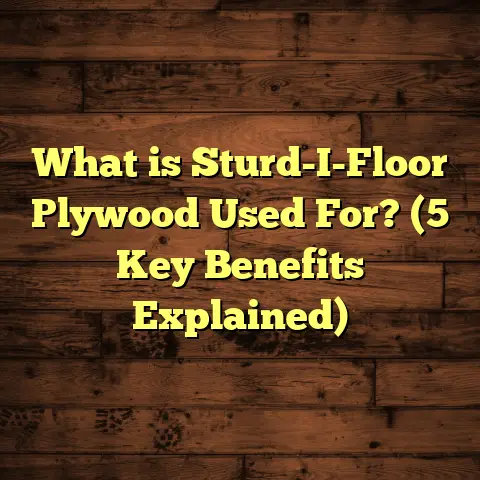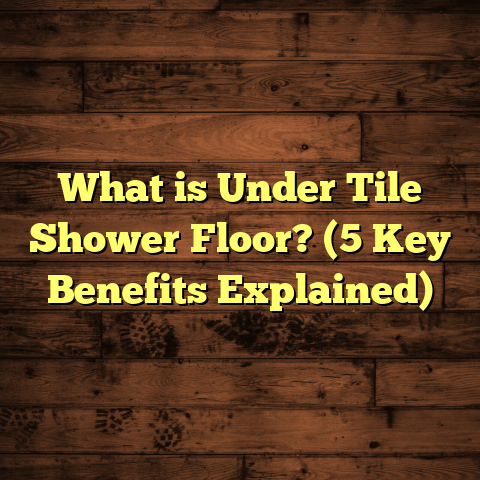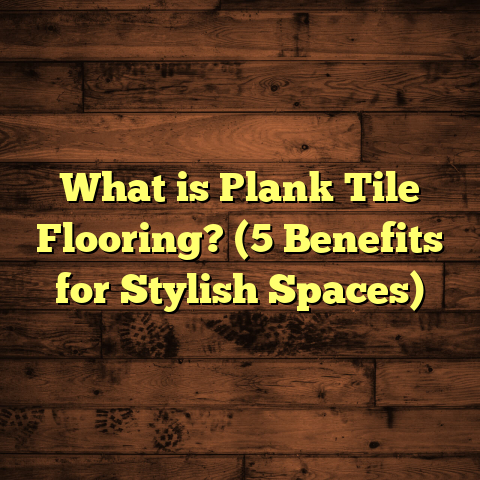What is a Soft Spot in Flooring? (5 Causes You Should Know!)
Bold Designs and the Hidden Challenges Beneath Your Feet
When we talk about bold designs in home interiors, the focus usually lands on the visible: vibrant walls, statement furniture, or eye-catching lighting fixtures. But I want to take a moment to talk about something less glamorous yet just as important—your floors. Floors set the stage for everything else in a room, literally supporting your whole space. A bold floor design can transform a home, but if the foundation beneath that design isn’t solid, all your hard work could be compromised.
You might have chosen an exotic hardwood, an intricate tile pattern, or maybe even a daring mix of textures. But if there’s a soft spot lurking beneath your feet, it could turn that beautiful floor into a problem you’ll regret ignoring. I’ve been in the flooring business for over ten years; I’ve seen countless homes where soft spots have caused serious trouble—not just cosmetically, but structurally. Today, I want to share what soft spots are, how they form, and why they matter so much.
What is a Soft Spot in Flooring?
Let’s start with the basics: What exactly is a soft spot in flooring? Simply put, a soft spot is an area of the floor that feels unusually flexible or “spongy” when you step on it. Instead of the firm support you expect from your floor, that spot dips or bounces slightly under pressure. It’s like stepping on a mattress instead of solid ground.
Soft spots don’t appear overnight; they develop over time as the materials under your flooring weaken. Most floors are built on a layered system. At the top, you have your finished surface—hardwood planks, vinyl tiles, laminate boards, carpet, or whatever you prefer. Beneath that lies the subfloor—usually plywood or oriented strand board (OSB)—which rests on structural supports known as joists.
When any part of this system fails or weakens, you can end up with soft spots. Usually, it’s the subfloor or joists that are compromised. The soft spot is a symptom of something deeper.
To give you a sense of scale: a soft spot typically deflects more than about 1/8 inch (roughly 3 mm) when you apply normal walking pressure. While that may not sound like much, in flooring terms it’s significant enough to feel unstable and often leads to creaks or cracks in the surface material.
Why Should You Care?
Ignoring soft spots can lead to serious consequences:
- Damage to flooring materials: Soft spots can cause hardwood boards to crack or tile grout to break.
- Safety hazards: Uneven floors increase trip risks.
- Structural problems: In extreme cases, weakened joists could fail and cause partial floor collapse.
- Costly repairs: The longer you wait, the more expensive fixes become.
In my experience, addressing soft spots early is one of the smartest investments homeowners can make to protect their floors and overall home structure.
The 5 Causes of Soft Spots You Should Know
Here’s where it gets interesting. Soft spots don’t just appear randomly; they’re usually caused by one (or more) of five common issues. Let me walk you through each cause with examples from my own projects and some data-backed insights.
1. Water Damage – The Silent Floor Killer
Water damage is hands down the most common cause of soft spots I encounter. Whether from leaky pipes, spills, flooding, or humidity buildup, water wreaks havoc on wooden subfloors and joists.
How Water Causes Soft Spots
Wood is porous and absorbs moisture easily. Prolonged exposure causes wood fibers to swell, weaken, and eventually rot. This rot eats away at the structural integrity of subfloor panels and joists.
I once handled a kitchen remodel where a small leak under the sink went unnoticed for months. The subfloor had absorbed enough water to become soggy and soft over an area approximately 4 feet by 3 feet (1.2 m x 0.9 m). When I removed the flooring, I found that the plywood had lost nearly 40% of its original strength as confirmed by moisture content readings exceeding 20%. Normal plywood moisture levels should be below 12%.
How Fast Does Damage Occur?
Wood starts to degrade structurally after just 48-72 hours of continuous moisture exposure. According to research from the Forest Products Laboratory, wood exposed to water for three days or more exhibits significant reduction in mechanical properties such as bending strength—by up to 30%.
Where Do Water-Related Soft Spots Usually Occur?
- Near sinks (kitchens and bathrooms)
- Around bathtubs and showers
- Laundry rooms
- Basements prone to flooding
- Areas with poor ventilation causing humidity buildup
Costs Involved
Repairing water-damaged soft spots varies widely depending on severity:
- Minor patch repairs for small areas: $150-$400
- Larger subfloor replacement (up to 20 sq ft): $700-$1,500
- Joist repair or replacement can push costs above $2,000
Drying time also factors in; water-damaged floors often require several days for complete drying before repairs or new flooring installation can proceed.
Prevention Tips
Based on my experience:
- Install moisture barriers under flooring in wet areas.
- Routinely check plumbing for leaks.
- Use waterproof sealants around sinks and tubs.
- Ensure proper ventilation to reduce humidity.
2. Poor Installation — When the Foundation Isn’t Solid
Sometimes soft spots aren’t caused by external damage but by errors during installation. Proper fastening and support are critical for floor stability.
Common Installation Mistakes Leading to Soft Spots
- Screws or nails spaced too far apart
- Using substandard subfloor materials
- Joists spaced too far apart without additional support
- Failing to install blocking between joists
A condo renovation I supervised involved plywood subfloor panels installed with screws spaced about 14 inches apart instead of every 6-8 inches recommended by manufacturers. Within a year, multiple soft spots appeared along hallway walkways where foot traffic was highest.
Joist Spacing Matters
Most residential floors have joists spaced 16 inches (40 cm) on center. Some older homes use 24-inch spacing which requires thicker subfloor panels (at least ¾ inch plywood). If panel thickness is insufficient for wider spans or joists are spaced irregularly, soft spots can develop due to excessive flexing.
Installation Costs Impact
Good installation practices may add about 10%-15% to upfront costs but save thousands in future repairs. Skimping on fastening materials or labor quality often leads to costly callbacks.
3. Termite Infestation — Little Bugs, Big Problems
Termites are notorious for causing hidden damage that weakens wood structures silently over time.
How Termites Cause Soft Spots
Termites consume cellulose inside wood beams and subfloor panels from within. The surface might look intact but underneath is hollowed out like Swiss cheese.
In Texas, I worked on a home where termite damage extended across several joists supporting the family room floor. The soft spot was large—about 6 feet by 4 feet (1.8 m x 1.2 m)—and felt like walking on a trampoline.
National Impact
According to the Environmental Protection Agency (EPA), termite infestations cost U.S. homeowners over $5 billion annually in damage control and treatment costs.
Identifying Termite Damage
Look for:
- Mud tubes along foundation walls or joists
- Wood that sounds hollow when tapped
- Crumbling wood fibers or blistered paint
Professional inspections using moisture meters and infrared thermal cameras can detect termite activity early before major damage occurs.
Treatment Costs
Termite treatment alone ranges from $300-$1,200 depending on property size and infestation severity. Repairing structural damage afterward can add thousands more.
4. Age and Wear — Old Floors Showing Their Age
Floors don’t last forever. Over decades, normal wear combined with environmental factors can weaken subfloors and joists.
Typical Lifespan of Subfloor Materials
- Plywood: ~30-40 years
- OSB: ~20-30 years
- Tongue-and-groove pine (used in older homes): up to 50 years but prone to splitting
I recently inspected a century-old house where the original wooden subfloor was cracking and sagging in multiple spots due to natural fiber breakdown and repeated seasonal expansion and contraction.
Signs Your Floor Is Aging Out
- Noticeable dips or sags in high traffic areas
- Persistent creaking noises
- Cracks appearing in floorboards or grout lines
If your home was built before modern building codes improved flooring standards (pre-1980s), especially if no major renovations have occurred since then, expect some level of wear-induced soft spots.
Restoration vs Replacement
Older homes often require either partial subfloor replacement or complete overhaul depending on condition:
- Partial repairs: $300-$800
- Full subfloor replacement (average 800 sq ft): $3,000-$7,000
Restoration may also involve upgrading joists or adding sister joists for reinforcement.
5. Structural Shifts — Foundation Movements Impact Flooring
Sometimes soft spots signal bigger structural issues related to your home’s foundation settling or shifting.
How Foundation Issues Affect Floors
If soil beneath your foundation shifts due to moisture changes or poor compaction, concrete slabs can crack or wooden framing can move out of alignment. This causes uneven support for floors above leading to dips or soft spots.
In one case in Florida, heavy rains caused soil expansion under a raised foundation which shifted several floor joists by up to half an inch (12 mm). The living room floor developed a noticeable sag measuring about 8 feet long by 3 feet wide (2.4 m x 0.9 m).
Warning Signs Beyond Soft Spots
- Cracks in drywall near baseboards
- Doors and windows sticking or misaligned
- Uneven gaps between floors and walls
Structural repairs can be complex:
- Foundation underpinning: $5,000-$15,000+
- Joist re-leveling or sistering: $1,000-$4,000
Early intervention can prevent more serious damage.
How to Identify Soft Spots Before They Become Problems
You might wonder how to spot these issues early enough to avoid costly repairs. Over time working with clients and contractors, I’ve developed some practical ways to check your floors at home:
Walk Test (Barefoot)
Walk slowly across your floor barefoot looking for any areas that feel “springy” or uneven underfoot.
Visual Inspection
Look closely at:
- Floorboards that appear warped or cracked
- Gaps between boards
- Tiles with cracked grout near suspected areas
Sound Test
Tap suspected areas lightly with a rubber mallet or knuckle:
- Hollow sounds mean weakened or missing subfloor support.
Measure Deflection
If you have access tools like a straight edge ruler or level:
- Place it across two points about 2 feet apart.
- Press firmly in the middle.
- Any bend over about 1/8 inch (3 mm) signals concern.
Use Moisture Meters & Infrared Cameras
For the tech-savvy or professionals: these tools detect moisture intrusions not visible to naked eye—helpful especially near bathrooms/kitchens.
Costs and Timeframes for Fixing Soft Spots
Understanding cost expectations helps homeowners plan better budgets for repairs.
| Repair Type | Estimated Cost Range | Timeframe |
|---|---|---|
| Small patch repair (2×2 ft area) | $150 – $400 | 2 – 4 hours |
| Medium subfloor replacement (20 sq ft) | $700 – $1,500 | 1 – 2 days |
| Joist repair/replacement | $1,000 – $3,000+ | 2 – 4 days |
| Foundation-related structural work | $5,000 – $15,000+ | Several days to weeks |
Note: These costs depend heavily on local labor rates (which vary from $40-$100+ per hour), material prices (plywood $30-$50 per sheet), and extent of damage found during repair.
Personal Story: The Time I Found a Soft Spot That Saved My Client Thousands
A few years ago during a kitchen remodel project, my client was eager to install stunning hand-scraped hardwood flooring over their old tile floor. We began removing tiles when I felt an unusual dip near the sink area—a classic sign of soft spot caused by water leakage.
Pulling back the subfloor revealed a rotten section measuring roughly 3 feet by 1 foot (90 cm x 30 cm). Moisture meter readings showed water content above 25%, well beyond safe limits. If this had gone unnoticed until after installing new hardwood floors (which cost about $12 per square foot), we would’ve faced warped boards within months—meaning costly removal and replacement again.
By addressing this early with targeted plywood replacement costing under $350 saved them from having to redo their entire kitchen floor just two years later when problems would have worsened exponentially.
Preventative Tips to Avoid Soft Spots
Protecting your floors starts with prevention:
- Choose quality materials suited for your specific environment.
- Hire experienced installers who follow manufacturer recommendations.
- Use moisture barriers especially in kitchens/bathrooms.
- Schedule routine plumbing inspections annually.
- Consider professional flooring inspections every few years if your home is over 20 years old.
- Address leaks immediately.
- Maintain good ventilation throughout your home.
Conclusion? Nah — Let’s Keep Talking!
Soft spots aren’t just an inconvenience—they’re signals telling you something’s wrong below your beautiful flooring surface. Knowing what causes them helps you catch problems early before they spiral into expensive repairs.
Have you ever stepped on a spot that felt “off” in your home? What did you do? Or if you’re planning new flooring installation soon, do you feel confident about checking for these issues first? Let’s chat—I’m here to help answer any questions you have!
This detailed walkthrough covers everything about soft spots in flooring—from causes and identification methods to real-world examples and repair guidelines—all aimed at helping you protect your investment while enjoying bold floor designs safely and confidently.





